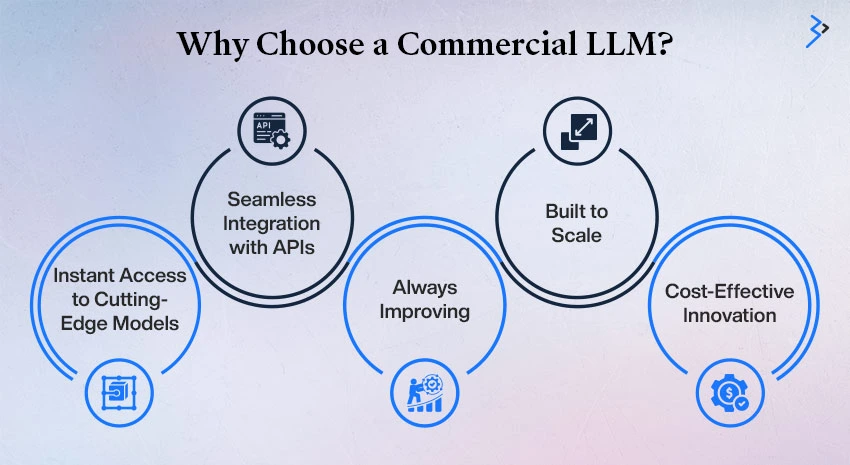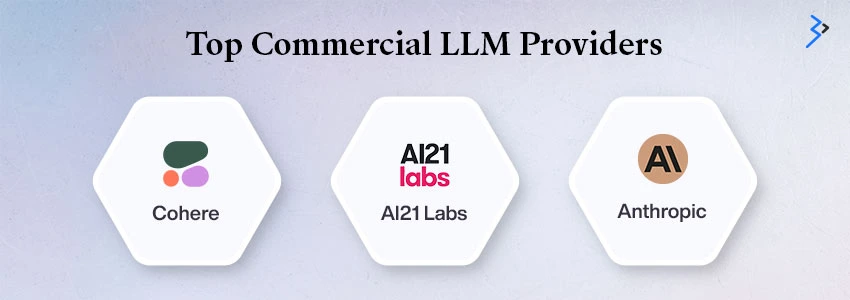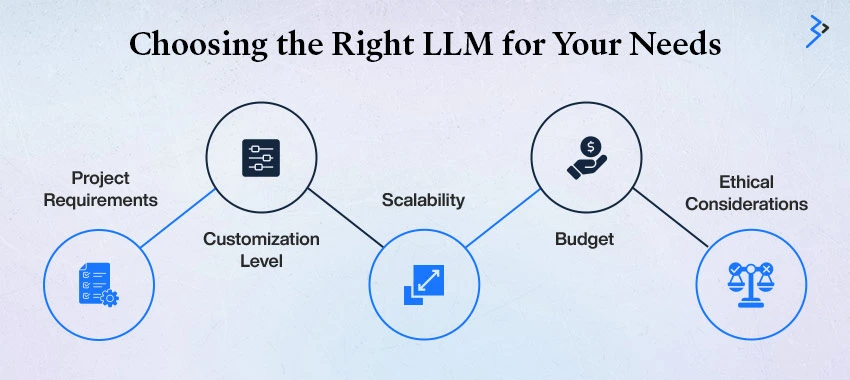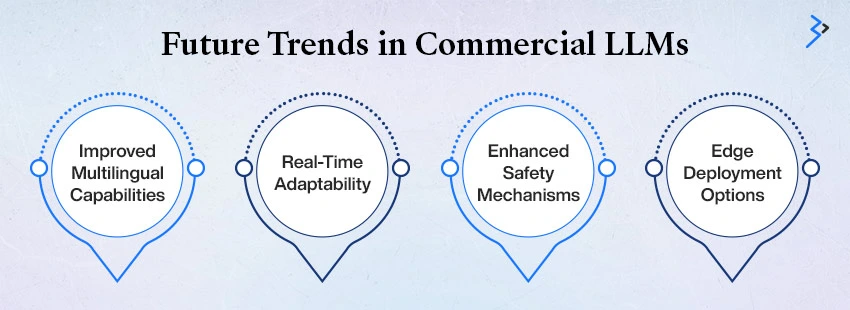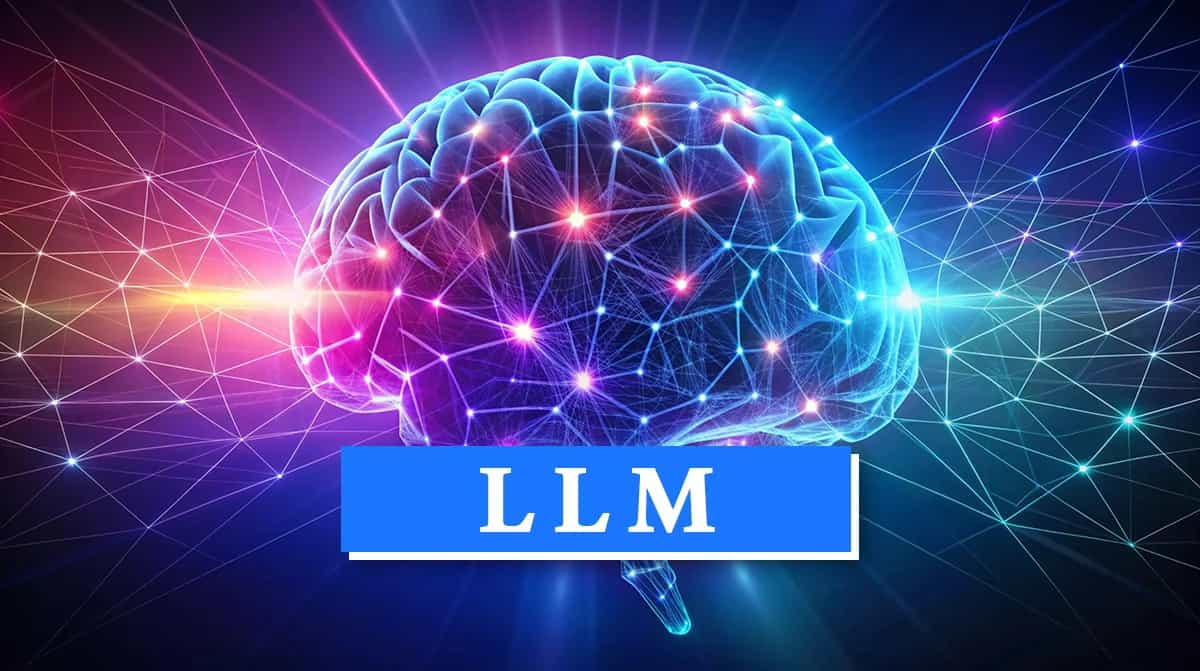Table of contents
Why Choose a Commercial LLM?
Top Commercial LLM Providers
Comparing Performance
Implementation: Getting Started with an API
Future Trends in Commercial LLMs
Wrap Up!
Large language models (LLMs) have progressed quickly, from research advances to fundamental elements of contemporary applications. Integrating a commercial LLM will reduce time, improve performance, and provide special features, whether your project is creating content-generating tools, sophisticated chatbots, or strong data analyzers.
Once generative artificial intelligence (gen AI) became popular; retail leaders had little time to see the promise before them in late 2022. With generation, AI is expected to unleash $240–$390 billion in economic value for retailers, or 1.2–1.9 percentage points of industry margin increase; the number of times artificial intelligence (AI) was brought up in retailers' earnings calls last year skyrocketed. This is hardly surprising. This and the usefulness of nongenerative artificial intelligence and analytics might transform billions of dollars in worth into trillions.
Most stores have begun experimenting with various types of artificial intelligence applications throughout the retail value chain during the last year. Few businesses have been able to fully utilize the technology's potential at scale, even with all this testing. Although most of the more than 50 retail executives we polled claim they are generally piloting and growing large language models (LLMs) and generative AI development services, just two executives say they have effectively applied gen AI throughout their companies.
Since using artificial intelligence requires rewiring elements of the retail business, including technological skills and personnel, some stores have found it challenging to apply it broadly. Data quality and privacy issues, inadequate resources and knowledge, implementation costs, and the pace at which stores may grow their own AI initiatives have also hampered their ability.
Successful retail firms that use general artificial intelligence usually shine in two main spheres. First, they consider how general artificial intelligence application cases may enable the transformation of specific sectors instead of allocating their efforts too thinly among several possibilities. Second, they deftly go from pilot and proof-of-concept to adoption at scale. This calls for data prioritizing, technology integration, and significant organizational reforms to enable general AI use.
In this blog, we will cover cost, performance, and essential features to assist you in selecting the ideal platform for your needs. It will also investigate how to use third-party LLMs such as Cohere, AI21 Labs, and Anthropic.
Why Choose a Commercial LLM?
Building a custom large language model (LLM) from scratch sounds exciting — but the reality? It’s a massive undertaking. You’d need extensive datasets, a high-powered infrastructure, and a team of machine-learning experts. Even then, maintaining and improving the model is an ongoing battle. That’s where commercial LLMs shine — they offer a faster, smarter, and more practical alternative. Let’s explore why they’re worth considering:
1. Instant Access to Cutting-Edge Models
Why spend months training a model when you can immediately tap into pre-trained, state-of-the-art solutions? Commercial LLMs come battle-tested, ready to understand, generate, and analyze language immediately. Whether generating content, powering chatbots, or analyzing data, you’ll get results without the wait.
2. Seamless Integration with APIs
Commercial LLMs are built for convenience. With API-based access, integrating these powerful models into your existing infrastructure is a breeze. There is no need to reinvent the wheel—just plug in the API and leverage advanced language capabilities in your applications, websites, or services.
3. Always Improving
Machine learning never stands still — and neither do commercial LLM providers. These platforms continuously roll out updates, optimizations, and new features. That means your applications stay sharp, responsive, and competitive without you lifting a finger.
4. Built to Scale
Whether you’re handling a handful of queries or processing millions of interactions daily, commercial LLMs are designed to scale effortlessly. They adapt to fluctuating workloads, ensuring smooth performance even when demand spikes.
5. Cost-Effective Innovation
Building and training an in-house LLM requires hefty upfront investments in data, hardware, and expertise — not to mention ongoing maintenance costs. Commercial LLMs eliminate that financial burden, offering flexible pricing models based on usage. You only pay for what you need, making advanced language technology accessible to businesses of all sizes.
Commercial LLMs are more than a shortcut — they’re a strategic advantage. They let you focus on creating innovative applications and enhancing user experiences rather than getting tangled in the complexities of model development. When speed, performance, and cost matter, going commercial isn’t just practical — it’s powerful.
Top Commercial LLM Providers
The commercial landscape of large language models (LLMs) is evolving rapidly, with several standout providers offering unique capabilities tailored to different business needs. Let’s dive into three leading platforms: Cohere, AI21 Labs, and Anthropic.
1. Cohere
Cohere has emerged as a powerful force in the LLM space, offering versatile language models designed for both developers and enterprises. Its strength lies in providing robust natural language understanding (NLU) and generation (NLG) capabilities, making it ideal for businesses building intelligent, language-driven applications.
Key features of Cohere include:
- Natural language processing: Supports advanced understanding and generation, enabling tasks like content creation, sentiment analysis, and chatbot development.
- Embedding models: Facilitates semantic search, classification, and recommendation systems by transforming text into dense vector representations.
- Multi-language support: Offers global accessibility, supporting a wide range of languages to serve diverse markets.
- Custom fine-tuning: Allows businesses to train the model on their specific datasets, enhancing accuracy for domain-specific applications.
Pricing: Cohere offers flexible pay-per-use pricing based on the tokens processed and customizable enterprise plans for large-scale deployments.
Ideal use cases: Content generation, customer support automation, knowledge retrieval, and building intelligent search systems.
2. AI21 Labs
AI21 Labs stands out for its human-like language generation capabilities, offering one of the most advanced models available — the Jurassic-2 family. This platform is particularly well-suited for businesses that require sophisticated content creation and conversational AI.
Key features of AI21 Labs include:
- Jurassic-2 models: Available in different sizes to balance performance and cost, making them adaptable for varied tasks.
- Task-specific API endpoints: Includes specialized tools for summarization, paraphrasing, and more, reducing development complexity.
- Memory persistence: Supports multi-turn conversations with contextual memory, essential for interactive chatbots and virtual assistants.
- Custom model development: Enterprise clients can collaborate with AI21 Labs to create customized models for their unique requirements.
Pricing: AI21 Labs offers a usage-based pricing model with tiered plans alongside customizable pricing for high-volume or enterprise-level solutions.
Ideal use cases: Long-form content creation, creative writing, personalized marketing, and developing conversational agents.
3. Anthropic
Anthropic distinguishes itself with a strong focus on AI safety, transparency, and reliability. Its flagship model, Claude, is built to prioritize ethical considerations, making it particularly attractive to industries handling sensitive data or operating in regulated environments.
Key features of Anthropic include:
- Ethical AI design: Emphasizes minimizing harmful outputs and ensuring responsible content generation.
- Contextual understanding: Supports processing of long documents, ideal for summarizing lengthy reports or conducting in-depth analysis.
- Adjustable behavior: This feature enables businesses to fine-tune the model’s behavior to align with their brand’s tone and ethical guidelines.
- Privacy-centric architecture: Prioritizes data security and compliance, a crucial factor for industries like healthcare and finance.
Pricing: Anthropic offers competitive token-based pricing, with customized plans available for enterprises seeking tailored solutions.
Ideal use cases: Regulatory-heavy sectors like healthcare, finance, and legal services, where reliability and ethical considerations are paramount.
Comparing Performance
| Feature | Cohere | AI21 Labs | Anthropic |
| Ease of Integration | API-first, developer-friendly | Versatile endpoints | Secure, guided setup |
| Customization | Fine-tuning supported | Task-specific models | Behavior tuning |
| Language Support | Multilingual | Primarily English | English, with context focus |
| Safety & Ethics | Moderate safeguards | Balanced performance | Strong ethical stance |
| Performance | High-speed, scalable | Human-like text quality | Robust, reliable output |
| Pricing | Pay-per-token, flexible | Tiered, usage-based | Competitive, token-based |
Choosing the Right LLM for Your Needs
Selecting the ideal Large Language Model (LLM) for your business isn’t a one-size-fits-all decision. Evaluating multiple factors ensures the model aligns with your goals, resources, and ethical standards.
- Project Requirements: Define the primary goal of your LLM integration. Are you building a content generator, semantic search tool, or conversational AI? Each task may require different models optimized for performance in that domain.
- Customization Level: Consider how much flexibility you need. Some LLMs offer pre-built endpoints for fast deployment, while others support fine-tuning, allowing you to train the model on domain-specific data for more precise results.
- Scalability: Think long-term. If you expect user demand or data volume to skyrocket, prioritize an LLM with strong scalability, ensuring consistent performance even under heavy workloads.
- Budget: Evaluate both upfront costs and ongoing expenses. Token-based pricing models mean longer inputs and outputs cost more — so optimizing token usage is key to controlling costs without sacrificing performance.
- Ethical Considerations: Businesses increasingly prioritize responsible AI. Look for LLMs with built-in safety mechanisms to reduce harmful bias, ensure data privacy, and maintain compliance with regulations like GDPR or HIPAA if handling sensitive data.
Choosing the right LLM isn’t just about technology — it’s about aligning capabilities with your business strategy. Whether you need fast, ready-to-go AI or a highly tailored solution, assessing your needs ensures sustainable, impactful implementation.
Implementation: Getting Started with an API
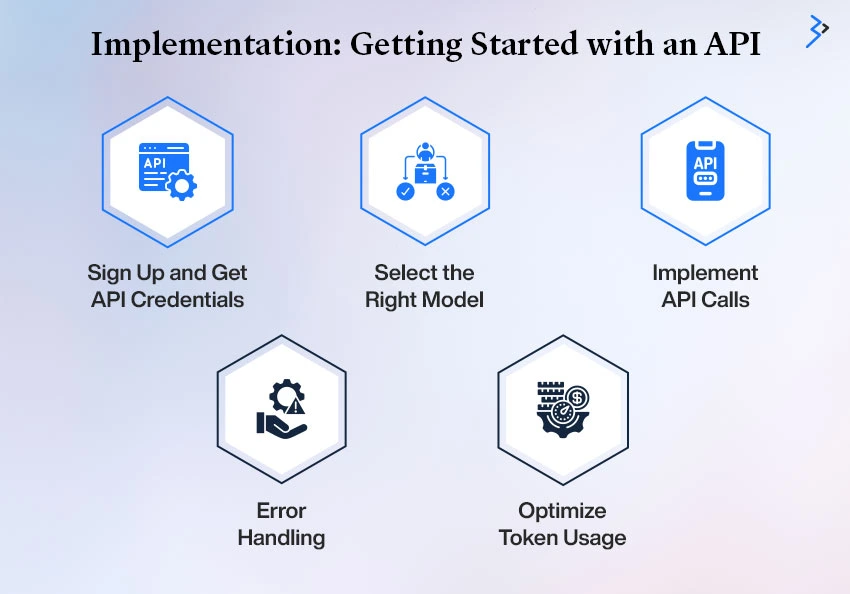 Integrating a Large Language Model (LLM) into your workflow starts with setting up the right API. While different providers may vary slightly, most follow a similar setup process:
Integrating a Large Language Model (LLM) into your workflow starts with setting up the right API. While different providers may vary slightly, most follow a similar setup process:
- Sign Up and Get API Credentials: Register with your chosen LLM provider and secure your API key — this authenticates your requests.
- Select the Right Model: Choose an LLM suited to your specific task, whether it’s content generation, summarization, or sentiment analysis.
- Implement API Calls: Structure requests to send user inputs and handle model responses. Most APIs support RESTful formats like JSON, making integration straightforward.
- Error Handling: Design your system to manage errors effectively. Gracefully handle rate limits, timeouts, and unexpected outputs to maintain performance and user experience.
- Optimize Token Usage: Monitor and streamline the number of tokens (input and output text length) to balance cost and performance significantly when scaling.
Many providers offer SDKs or pre-built libraries in languages like Python, JavaScript, or Node.js for faster implementation. By focusing on error handling and cost efficiency early, you ensure a smoother, more scalable LLM integration that supports future growth.
Here’s a basic example using Cohere’s API:
import cohere
co = cohere.Client('YOUR_API_KEY')
response = co.generate(
model='command-xlarge-nightly',
prompt='Write an engaging blog post introduction about AI.',
max_tokens=300
)
print(response.generations[0].text)
Future Trends in Commercial LLMs
The landscape of large language models (LLMs) is evolving at an unprecedented pace, driven by advancements in AI technology and market demands. Businesses increasingly adopt LLMs to enhance productivity, customer engagement, and decision-making. Here’s a glimpse into the future of commercial LLMs:
- Improved Multilingual Capabilities: Future LLMs will support more languages with greater fluency and cultural context, enabling businesses to engage global audiences seamlessly.
- Real-Time Adaptability: LLMs will learn and adapt on the fly, delivering more personalized, context-aware responses based on evolving user inputs and preferences.
- Enhanced Safety Mechanisms: As misinformation and bias remain critical, next-generation LLMs will incorporate advanced safeguards to ensure ethical, accurate, and trustworthy outputs.
- Edge Deployment Options: To reduce latency and reliance on cloud infrastructure, businesses will increasingly leverage on-device LLM processing for faster, more responsive experiences — especially in IoT and mobile environments.
- Vertical-Specific Models: Industry-tailored LLMs will emerge and be optimized for sectors like healthcare, finance, and gaming, offering domain-specific knowledge and precision.
In addition, advancements in energy-efficient architectures will make running LLMs more sustainable and cost-effective. We’ll also see stronger integrations with automation tools, empowering businesses to scale complex workflows faster.
The future of commercial LLMs promises more than just smarter conversations — it’s about reshaping how businesses operate, innovate, and connect with customers worldwide.
Wrap Up!
Integrating 3rd party LLMs like Cohere, AI21 Labs, and Anthropic enables faster development, more innovative applications, and better performance. You can find the ideal platform to power your AI-driven solution by carefully evaluating features, pricing, and performance. Whether you prioritize flexibility, content quality, or ethical considerations, today’s commercial LLMs offer an impressive array of options to fit your needs.
Ready to transform your application with cutting-edge AI? Start exploring these LLM platforms today — and unleash the true potential of your software!
Related Articles
Digital Transformation
Open LLMs: Unlocking the Power of AI-Language for Everyone
Digital Transformation
RAG (Retrieval-Augmented Generation): Making LLMs Smarter with Real-Time Data
Digital Transformation
Exploring Generative AI’s Revolutionary Impact In Automotive Industry

